Surfacing the Accessible Playground: 7 Things Every Playground Owner Should Know About the Accessibility of Their Playground Surfaces
3. Review the Research Findings About Accessibility Issues for Play Surfaces
From 2008 to 2012, the National Center on Accessibility at Indiana University-Bloomington, conducted a longitudinal study on the accessibility of playground surfaces. The study was funded by the U.S. Access Board. The purpose of this study was to evaluate a variety of playground surfaces, their ability to meet accessibility requirements, their costs upon initial installation and maintenance issues over a 3-5 year period.
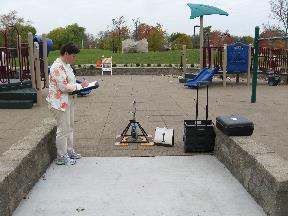
The research design for this study of playground surfaces began in 2005 with input from a national advisory committee. During the study, quantitative and qualitative data was collected through on-site inspections for a 3-5 year period. A national advisory committee provided feedback on the categories of surfaces to be evaluated, the criteria to be used for evaluation, the locations within each playground to be evaluated, data collection worksheets and on-site protocol. In addition, advisory committee members helped to expand the network for recruitment in the study and increase national awareness among playground owners.
The sample population for this study depended upon an established, or to be established, congenial relationship with the playground owner and the research team. The data for analysis required the research team to make a number of inquiries to the operation, planning, budgeting and maintenance procedures conducted by the playground owner. Most importantly, if there were any instances where locations on the playground were found to be in non-compliance with the accessibility or safety guidelines, the playground owner was to be informed and then carried the burden of bringing those instances into compliance.
Approximately 35 playground sites were recruited for participation during the evaluation period from October 2008 through May 2011. Data collection concluded in September 2012 so that all playground sites in the study would have a minimum of two years of data. All of the playground sites were located in public parks owned/operated by 16 different municipalities from Indiana, Illinois and Michigan. Sites included either neighborhood playgrounds or those located in regional parks. The 16 participating municipalities operated anywhere from 4 to 53 playgrounds each. None of the playground owners were “first time” owners. All of the owners had a history of managing playgrounds. They considered themselves somewhat knowledgeable of playground surface issues and eager to learn how they could improve upon their playground surface maintenance efforts for costs savings.
The playground surface products considered for this study had to initially meet the requirements of the accessibility standards for: accessible routes; ground surfaces; the ASTM F1292-99/04 Standard Specification for Impact Attenuation of Surface Systems Under and Around Playground Equipment as determined by the surface manufacturer in laboratory testing; and the ASTM F1951-99 Standard Specification for Determination of Accessibility of Surface Systems Under and Around Playground Equipment as determined by the surface manufacturer in laboratory testing. Information on the surface vendor, specifications, costs and labor for installation was then collected. In turn, the research team contacted each vendor to collect additional information on laboratory certification with ASTM F1951-99 for each surface.
Five categories of surfaces were studied: poured in place rubber (PIP), rubber tiles (TIL), engineered wood fiber (EWF), shredded rubber (SHR) and hybrid (HYB) systems. Nine critical areas were inspected within 12 months of installation and continued to be evaluated at least once a year for the longitudinal study:
- Entry to playground where playground surface starts;
- Accessible route connecting accessible play elements;
- Egress point of slide(s);
- Swings;
- Entry point(s) to composite structure(s)/transfer stations;
- Climber(s);
- Ground level play element(s) such as spring rockers, play tables, interactive panels, etc;
- Sliding poles; and
- Other areas (i.e. water play elements, etc).
A preliminary accessibility assessment of the playground surface was conducted and the surface tested for firmness and stability with the Rotational Penetrometer. At the discretion of the playground owner, the playground surface was also tested for impact attenuation with the TRIAX (surface impact testing device). The playground owner was notified immediately of test results for both the Rotational Penetrometer (firmness/stability) and the TRIAX (impact attenuation) and given opportunity to correct surfaces where deficiencies or non-compliance with standards were noted.
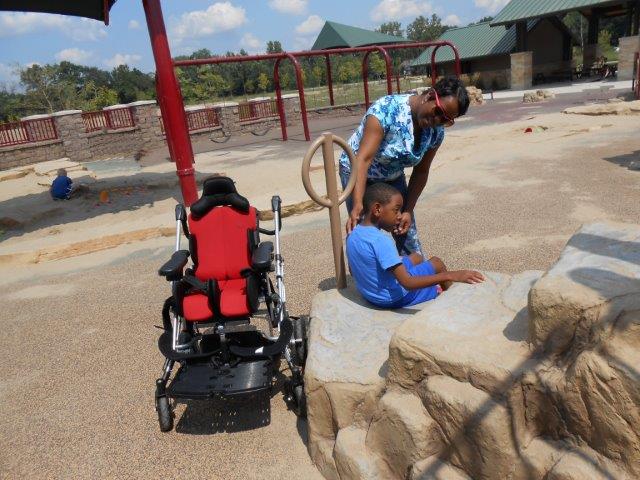
NCA Play Surface Study Findings
The most valuable lesson to be learned from this longitudinal study is that there is no perfect playground surface. Even within 12 months of installation, each type of surface had some type of issue or series of issues that affected the product’s performance and contributed to the necessity and frequency of surface maintenance to assure accessibility and safety for use by children on a daily basis. A playground surface with poured-in-place rubber had a use zone found in non-compliance with the ASTM standard for impact attenuation. Playgrounds surfaced with tiles were observed with puncture holes, buckling and separating seams that created openings and changes in level on the accessible route. Inaccessible routes with undulating surface material were identified at playgrounds with engineered wood fiber. Each occurrence and event was weighed and balanced with the product’s feature advantages and drawbacks. The information can serve as guidance to both future playground planning and priorities for designing new research. The following are the predominant findings from this study:
- No single type of surface material/system was found to be the most accessible surface or better than others when comparing its ability to meet the accessibility standards with issues related to installation and maintenance.
- Within 12 months of installation, playground sites in the sample with the loose fill EWF were found to have the greatest number of deficiencies, such as excessive running slope, cross slope, and change in level, affecting the accessible route to play components.
- Within 12 months of installation, playground sites in the sample with loose fill EWF were found to have the highest values for firmness and stability, indicating greater work force needed to move across the surface, while playground sites with the unitary surfaces TIL and PIP were found to have the lowest values for firmness and stability– indicating less work force necessary to move across the surface.
- Deficiencies (excessive running slope, cross slope, change in level, or openings) for PIP, TIL and HYB began to emerge 24-36 months after installation.
- Occurrences were identified in the sample where the surface material installation did not parallel either the manufacturer’s installation instructions or the procedural instructions on the laboratory test sample for ASTM F1951-99.
- A playground surface with fewer accessibility deficiencies and a lower measurement for firmness and stability did not necessarily meet the safety standards for impact attenuation.
- Surface cost for material cannot serve as an indicator or predictor of performance.
The full report A Longitudinal Study of Playground Surfaces to Evaluate Accessibility: Final Report is available on the National Center on Accessibility web site: http://www.ncaonline.org/.
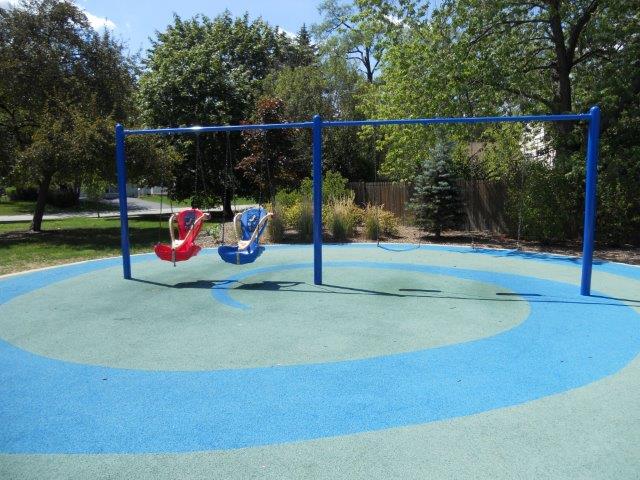
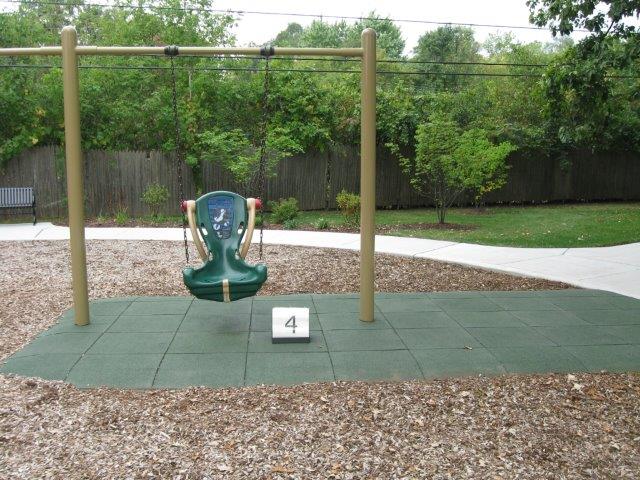
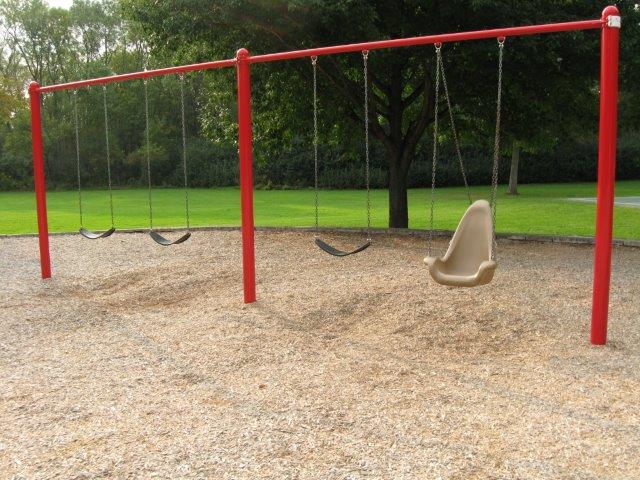
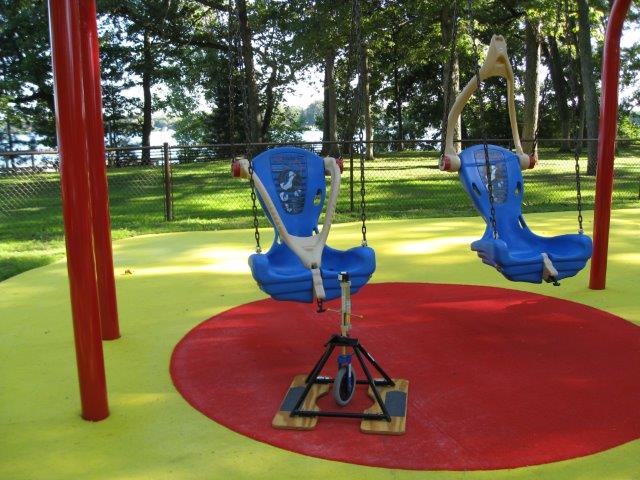
| Comparison of Playground Surfaces Evaluated in NCA Longitudinal Research Study | |||
| Poured in Place Rubber (PIP) | Tiles (TIL) | Engineered Wood Fiber (EWF) | Hybrid Surface Systems (HYB) |
|
DESCRIPTION Wear layer with larger rubber particles and finished with a custom top layer of granular particles. A binding agent is used and the material is poured out on site or “in place” as it gets its name. |
DESCRIPTION Bonded rubber constructed as 2 ft x 2 ft squares with interlocking sides. |
DESCRIPTION ASTM defines EWF as processed wood ground to a fibrous consistency, randomly sized, approximately 10 times longer than wide with a maximum length of 2 inches. Free of hazardous substances. Not to be confused with wood chips. |
DESCRIPTION Multi-layer system where the base layer may consist of either contained or loose particles like shredded rubber or carpet pad. The top layers may be outdoor carpeting, artificial turf, or rubber top mat. |
|
COST (Average market cost 2009-2012)(MATERIAL ONLY) $6.59 to $19/sq ft |
COST (Average market cost 2009-2012)(MATERIAL ONLY) $8.96 to $21/sq ft |
COST (Average market cost 2009-2012)(MATERIAL ONLY) $ 0.74 to $2.50/sq ft |
COST (Average market cost 2009-2012)(MATERIAL ONLY) $7.50 to $12.65/sq ft |
|
INSTALLATION Installer must be specially trained/certified by the manufacturer. |
INSTALLATION Can be installed by contractor or park/facility personnel. Learning curve associated with installation. |
INSTALLATION Can be installed by contractor or park/facility personnel. |
INSTALLATION Installer must be specially trained/certified by the manufacturer. |
|
REPAIRS Repairs must be conducted by trained installer. |
REPAIRS Repairs may be completed by contractor or park/facility personnel. |
REPAIRS Repairs may be completed by contractor or park/facility personnel. |
REPAIRS Usually repairs must be conducted by the installer. In some cases, park/facility personnel may be trained to make smaller repairs. |
|
COMMON ACCESSIBILITY ISSUES Cracking or flaking of the top layer can lead to divots and openings greater than 1/2 inch. Top layer deficiencies are often accelerated in high use areas (under swings, slides, teeter-totters). Results in non-compliant routes and clear ground spaces at equipment. May also result in non-compliant cross slope at entry/egress. Surface deficiencies can be traced to improper binding agent ratio, inability for product to properly cure, and deterioration of product over years of exposure to the elements. |
COMMON ACCESSIBILITY ISSUES Puncture holes and shifting seams can create openings and changes in level along the accessible route and at clear ground space for equipment. Foreign particles can lodge in seams causing separation including lift from adhesive for subsurface. Instances of cracking may occur as the product ages. Settled or washed out subsurface may compromise structural integrity of individual tiles. |
COMMON ACCESSIBILITY ISSUES Improper installation and/or maintenance can result in undulation across the horizon of the surface affecting running slope, cross slope and change in level. Product material should be installed in layers and compacted in order to achieve an accessible route and level clear ground space at equipment. Surface material is likely to displace at heavy use areas with motion, such as at swings, slides, sliding poles, climbers, spinners and teeter totters. Displaced material should be raked level and compacted before additional fill is added. |
COMMON ACCESSIBILITY ISSUES Seams may separate or detach from the border creating changes in level and openings affecting the accessible route. Shifting of loose fill in the base layer may affect running and cross slopes. The artificial turf top layer may experience build-up of static electricity requiring application of anti-static solution. |

User Comments/Questions
Add Comment/Question